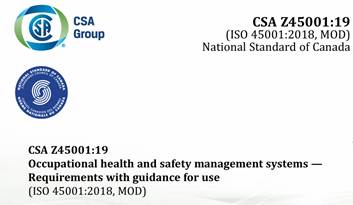In-depth look at ISO 45001 and its Canadian cousin CSA Z45001


“Opinions have vested interests just as men have.”
—Samuel Butler, 1835–1902
|
Many environmental, health, safety and quality (HSEQ) initiatives have surfaced internationally over the past years. Expectations for corporations are rising even as these initiatives compete for recognition and acceptance. For the past several decades, notable disasters such as the Bhopal and Exxon Valdez accidents, as well as more chronic environmental issues such as deforestation and the depletion of the ozone layer, have done much to heighten the world’s concerns over the environment by generating support for establishing a “level global playing field” that protects the environment while allowing for sustainable development. In recent years the “sustainability” and “climate-change” revolution has transformed heretofore recalcitrant companies into leading proponents of the environmental-sustainability philosophy. |
ISO Standards
The Standards with probably the most potential long-term impact for HSEQ audit validity are those crafted by the International Organization for Standardization. ISO has a long history of developing quality standards (i.e., the ISO 9000 series) that are firmly entrenched in the developed world, including the United States, Canada, Europe and Asia.
In some industries (e.g., automotive, electronics), becoming a registered ISO 9000 company is almost mandatory. In time, a facility seeking ISO 9001 quality registration may be required to have or be seeking ISO 14000 EMS registration or ISO 45001 SMS registration as well. In fact, there are many organizations already pursuing this integrated, strategic HSEQ management and auditing approach in the experience of the authors. And while registration may or may not be mandated, many clients require at least some form of self-declaration or self-conformance to the requirements of these Standards. And the prudent and practical use of the guidance in these Standard can be realized by anyone with a desire for a disciplined approach to helping improve the HSEQ performance of their organization. Full Standard adherence is not required.
It might be prudent again to reference just a few of those Standards which are gaining traction nationally and internationally:
- ISO 9001 Quality Management Standard
- ISO 14001 Environmental Management Standard
- ISO 45001 Occupational Health and Safety Standard
- ISO 22301 Business Continuity Management Standard
- ISO 27001 Information Security Management Standard
- ISO 13485 Quality Management Standard for Medical Devices
- IATF 16949 Quality Management Standard for Automotive Sector
- AS9100 Quality Management Standard for Aerospace and Defense
ISO 45001
ISO 45001 is an International Organization for Standardization (ISO) standard for management systems of occupational health and safety (OHS), published in March 2018. The goal of ISO 45001 is the reduction of occupational injuries and diseases, including promoting and protecting physical and mental/psychological health. The standard is based on the old British Standard OHSAS 18001, conventions and guidelines of the International Labour Organization, and national standards. It includes elements that are additional to OHSAS 18001, which it is replacing over a three-year migration period from 2018 to 2021. ISO 45001 follows the High-Level Structure of other ISO standards, such as ISO 9001:2015 and ISO 14001:2015, which makes integration of these standards easier.
Adoption
ISO 45001 was adopted as a national standard by Albania, Argentina, Armenia, Austria, Australia, Azerbaijan, Belgium, Bolivia, Bosnia and Herzegovina, Brazil, Bulgaria, Canada, Chile, Colombia, Costa Rica, Croatia, the Czech Republic, Denmark, Ecuador, El Salvador, Estonia, Finland, Georgia, Germany, Greece, Honduras, Hungary, Iceland, India, Indonesia, Ireland, Israel, Italy, Japan, Kazakhstan, Latvia, Lithuania, Malaysia, Moldova, the Netherlands, New Zealand, North Macedonia, Norway, Paraguay, Peru, the Philippines, Poland, Portugal, Romania, Russia, Serbia, Singapore, Slovakia, Slovenia, South Africa, Sri Lanka, Sweden, Switzerland, Taiwan, Turkey, the United Kingdom, the United States, Uruguay, and Uzbekistan.
Canada in Focus

And don’t forget that for all the talk about ISO 45001, Canada is also a partner at the safety management system Standard table with the. And speaking of tables, for anyone wanting a better understanding of where ISO 45001 differs from CSA Z45001, the table below can be of benefit.
|
45001 Clause |
Canadian Deviation |
Summary of Additional/Modified Requirement |
|
General |
[Throughout Standard] |
Replace all references to “risks” (plural) with “risk” (singular). |
|
Intro 0.4 |
Plan-Do-Check-Act |
Rewording of Item a) to align with Canadian risk and hazard identification practices. |
|
5.3 |
Organizational Roles, Responsibilities, Authorities |
Add: Workers must have the authority to remove themselves from hazardous situations without fear of reprisal. |
|
7.3 |
Awareness |
Replace Item f): Workers must be aware of arrangements to remove themselves from hazardous situations without fear of reprisals. |
|
8.1.2 |
Eliminating Hazards and Reducing OH&S Risks |
Add: Organization must ensure PPE and training are provided where identified. Also includes a note clarifying that training/PPE can be provided via legal/other means. |
|
Annex A.4.2 |
Context – Interested Parties |
Revise text to clarify inclusion of worker representatives. Item d) deleted. |
|
Annex A.5.4 |
Consultation and Participation of Workers |
Revised paragraphs emphasize worker engagement in decision-making and protection from reprisal. |
|
Annex A.6.1.2.2 |
Assessment of OH&S Risks |
Replace “consultation” with “participation” in planning risk assessment. |
|
Annex A.8.1.1 |
Operational Planning and Control |
Entire clause replaced: Focus on enhancing OHS by eliminating hazards or minimizing risk, applying the hierarchy of controls. |
|
Annex A.8.1.2 |
Eliminating Hazards |
Add: Reduction of OHS risk must be iterative and based on the PDCA model. |
And for all the public and marketing talk about ISO 45001, CSA Z 45001 packs just as good a punch for my money, especially for the realities of the Canadian OHS landscape.
For those asking about CSA Z45001:2019 (R2023) and ISO 45001:2018, now that the Ontario Ministry of Labour just directed the IHSA to grant COR 2020 equivalency to firms that are certified under ISO 45001:2018, I broke out the following. Nothing specific from Ontario's Minister Puccini on CSA Z4500:2019 (R2023) to the best of my knowledge. Perhaps it's assumed? Hopefully. I guess time or the Minister will clarify.
CSA Z45001:2019 – Reflecting Canadian OHS Realities
1. Terminology Adjustments: CSA Z45001 includes terms and language that align with Canadian OH&S legislation and practices. For instance, terms like "competent person," "joint health and safety committees," and "due diligence" are framed in alignment with Canadian OHS language.
2. References to Canadian Legislation: The standard includes specific notes or annexes referencing Canadian legislative requirements, ensuring that organizations can better align with provincial and federal OH&S laws.
3. Worker Participation and Joint Health and Safety Committees (JHSC): There is a stronger emphasis on worker participation, a key element in Canadian OH&S systems, particularly through the role of joint health and safety committees (JHSC). CSA Z45001 reflects Canada’s requirement for JHSCs in workplaces over a certain size or risk level, which may not be explicitly required in ISO 45001.
4. Competency and Training Requirements: CSA Z45001 emphasizes competency requirements tailored to Canadian regulations. This includes specific competencies for roles like supervisors or safety representatives, in line with Canadian OH&S standards for a “competent person” who is qualified, knowledgeable.
5. Due Diligence and Legal Compliance: There is an added focus on "due diligence," which is central to Canadian OH&S legislation. such as through documentation, proactive risk assessments, and safety audits.
6. Psychosocial Hazards: CSA Z45001 places emphasis on the management of psychosocial hazards, which has gained attention in Canadian OH&S legislation. This reflects Canada’s increasing focus on workplace mental health and the need to manage stress, harassment, and other non-physical workplace hazards.
7. Emergency Preparedness and Response: Canadian-specific guidance is provided for emergency response planning, with notes on compliance with provincial and federal guidelines for emergency preparedness and response in workplaces, especially in high-risk industries like oil and gas or construction.
8. Localized Examples and Additional Notes: The CSA version includes Canadian-specific examples to illustrate compliance approaches, which may refer to specific industries or hazards commonly managed in Canada.
In summary, the CSA Z45001 standard is designed to ensure that organizations operating in Canada have a more direct framework for complying with Canadian OH&S laws and regulations, while still aligning with ISO 45001's international framework. These adaptations make it more practical for Canadian companies by addressing unique regulatory requirements, legal expectations, and cultural practices in OH&S.





